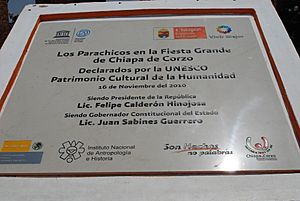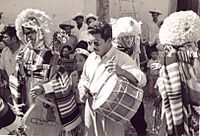Parachico facts for kids
The Parachico dancers are a special part of a big festival in Chiapa de Corzo, Chiapas, Mexico. They dance in the streets during the Grand Fiesta, which happens every year from January 15 to 23. This festival honors three important saints: the Black Christ of Esquipulas, Saint Anthony Abbot, and Saint Sebastian. Many people believe this festival mixes old traditions from the native people with newer Catholic and Spanish customs. It's a blend of different cultures!
The Grand Fiesta includes Roman Catholic religious events, music, dancing, and tasty local food. Because it's so unique and important, UNESCO added it to their Intangible Cultural Heritage Lists on November 16, 2010. It's officially known as "Parachicos in the traditional January feast of Chiapa de Corzo."
Contents
History of the Parachicos
The Parachico tradition has very old roots, even before the Spanish arrived. However, the way we see it today started around the 1600s. This was when the image of Saint Sebastian arrived in the town, which was then called the Royal Village of Chiapa.
There are a few stories about how the Parachicos began, but they all share a similar idea. One popular story tells of a rich Spanish lady named Señora María de Angulo. She came to Chiapa de Corzo from Guatemala in the 1700s because her son was very sick. Doctors couldn't help him, so she heard about a famous native healer in Chiapa de Corzo.
She traveled with many servants, and they would shout, "Clear the way for my lady María de Angulo!" The healer told her to bathe her son in the healing waters of Cumbujuyú for nine days. After doing this, her son got better, and she was very happy.
How the Parachicos Began
A few years later, in 1767 and 1768, a terrible plague of locusts destroyed all the crops in Chiapa. People suffered from hunger and sickness. Then, something amazing happened: a long line of mules arrived, loaded with corn, beans, vegetables, and money! It was Señora María de Angulo, who had returned to help the people.
Her servants gave out food to all the families. At night, the servants would dance and entertain the children. They even threw candy to them! They would tell the parents, "Remember your children, the gifts are for the children!" In Spanish, "for the children" is "para el chico." This is how the name "Parachico" came about.
Every year during the festival, a woman dressed as Señora María de Angulo rides in a special car. She throws out "gold coins" (which are actually sweets and confetti) to remember her kindness.
Honoring Señora María de Angulo
On some nights during the festival, the men of the town dress up as Spanish women. They parade through the streets. This is another way they honor Señora María de Angulo and her generosity.
What Parachicos Wear
Parachicos have a very special costume! They wear wooden masks that look like people with light skin, beards, and blue eyes. This is a contrast to the native people's features.
They also wear a round headdress with colorful ribbons. They put on striped serapes (a type of blanket cloak) and embroidered shawls. Usually, they wear these over a dark shirt and trousers.
Parachicos also carry metallic rattles. These rattles are called chinchin or chinchines. They have colorful ribbons attached to them. The dancers shake these rattles as they move and chant, making a unique sound.
A Special UNESCO Honor

On November 16, 2010, something very important happened for the Parachicos festival. UNESCO officially declared it an Intangible Cultural Heritage. This means it's a very special tradition that needs to be protected and celebrated.
The decision was made at a meeting in Nairobi, Kenya. The festival was recognized as "Parachicos in the traditional January feast of Chiapa de Corzo." This honor helps make sure that this amazing cultural tradition continues for many years to come!
See also
 In Spanish: Los Parachicos para niños
In Spanish: Los Parachicos para niños
- Chiapa de Corzo
- UNESCO Intangible Cultural Heritage Lists




